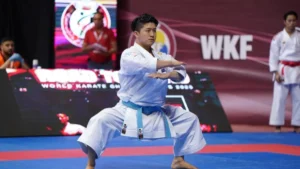Neck Strengthening Exercises: When it comes to grappling sports, such as Brazilian Jiu-Jitsu (BJJ) and Submission Grappling, the neck remains a critical aspect of your attack and defense weaponry. It becomes a vital role in executing central techniques such as the “bridge and roll” and acts as your main point of defense for numerous choke submissions.
Developing a strong and resilient neck will help you not only escape from bad positions but also boost your overall grappling skills, therefore, making you difficult to control on the mats.
Importance of Neck Strength in Grappling

Your neck goes through continual tension when you are involved in grappling arts. It’s subjected to different movements: rotation, flexion, and extension. This concept plays an important role in posture, defense, and general resistance to physical pressure. According to common sense, the neck has a considerable influence on grappling-take-downs, escapes, and submissions.
- Defense Against Chokes
Although neck strength itself won’t keep you from ever getting choked, it can deliver moments of life-saving resistance. Having strong muscles in your neck makes it hard for chokes to get purchase on you, and it gains you valuable seconds to defend and get out before the submission locks into place. Having extra muscle mass around your neck also absorbs some of the impact of a choke, preventing your opponent from finishing the lock.
- Having Good Posture
Good posture is the foundation of grappling. Whether defending from the bottom guard or attacking from the top, your neck is instrumental in holding a good, stable posture. A tough neck makes it more difficult for your opponent to break your posture, thereby denying them the ability to perform popular submission holds, like the triangle choke, which depends on shattering your balance. Also, in MMA, a well-developed neck assists you in staying in the upright position so that you can punch effectively from the top position without compromising your defense.
- Durability and Injury Prevention
Grappling can place a lot of stress on the body; the handle of a wrestling parent seems to be on the neck constantly. There is always some dragging having to do with the impact from takedowns, scrambles, and neck cranks. Indeed, having a good neck can help protect you from any kind of accident.
Muscles around your neck act as shock absorbers, cushioning the blow and evenly distributing forces, lessening the probability of strain or injury.
Anatomy of the Neck: Understanding the Key Muscles

Your neck is not comprised of one muscle but rather a system of muscles that collaborate to give movement, support, and stability. Some of the important muscles in your neck are:
– Sternocleidomastoids: On the sides of your neck, these muscles permit rotation and flexion of the head.
– Trapezius: This huge muscle covers the posterior aspect of the neck and serves to stabilize and support the entire neck area.
– Deep Cervical Flexors: Lesser muscles at the front of your neck, involved in head movement and upright posture.
To build a strong, enduring neck, these muscles need to be targeted using special exercises that concentrate on flexion, extension, and sideways movement.
Effective Exercises to Build a Strong Neck

Neck bridges are another staple exercise amongst wrestlers, as they build the muscles at the back of the neck and also work on flexibility and stability of the neck.
1. neck bridges:
– Lie on your back with your feet firmly on the ground.
– Drive through your feet to lift your hips high above the ground, transferring all body weight onto your head and neck.
– Hold the position for a second and then slowly lower your hips back to the ground to complete your rep.
Pro Tip: Concentrate on controlled movements and don’t hurry through the reps. Begin with three sets and progress to more repetitions as your neck gets stronger.
- Resistance Band Neck Flexion
This gives attention to the muscles right at the front of your neck. These are really important for maintaining posture and resisting neck cranks. For this exercise, you need a resistance band.
This band should then be placed around the head and attached to something strong. You should then step back to create tension in the band. To perform one rep, nod your head down and back to the initial position.
Pro Tip: Begin with a light resistance band, and after you can do 15 or more reps without difficulty, add resistance incrementally.
- Side Neck Raises
Side neck raises emphasize the development of the sternocleidomastoids, the muscles that move the neck laterally. These muscles are especially valuable for resisting lateral pressure and neck cranks. To do side neck raises:
– Lie on your side with your head overhanging a bench.
– Raise your head to your shoulder, hold it for a moment, and then return it to the starting position.
– Do 12-15 reps on one side before repeating on the other side.
Pro Tip: Begin with bodyweight and then add resistance using a neck harness or dumbbell as you become stronger.
Advanced Neck Training Techniques

After establishing a good foundation with fundamental neck exercises, it’s time to add more advanced training techniques. These exercises can offer progressive overload, which is essential for ongoing muscle growth and strength.
- Weighted Neck Harness
A neck harness is a wonderful tool to place an overload on the neck muscles. It allows one to perform exercises like neck flexion, neck extension, and lateral neck work under load. And the greater the resistance is, the more that strength and muscle mass can be built up if an appropriate training program is followed.
Pro Tip: Start light, gradually increasing the weight so you do not overstress your neck. Always use good form with controlled movements.
- Partner Drills
Pretty much any grappling drill can serve as a good neck-strengthening exercise; for example, one might positional drill with a partner where they try to break your posture and you fight to maintain stability in your neck and keep your torso upright. This will strengthen the muscles in your neck and help you control your posture in real situations.
Pro tip: Make sure you give your partner clear instructions on what you’re doing, so they give the proper amount of resistance in these drills.
- Neck Mobility Exercises
Neck flexibility is as crucial as strength. Adding neck mobility exercises like neck rolls and yoga stretches can keep muscles healthy and limber and prevent stiffness. These exercises enhance the range of motion and avoid neck injuries.
Pro Tip: Add neck stretches such as the cat-cow stretch to your cooldown routine to keep your neck muscles healthy and flexible.
Why Neck Strength is Important for Grapplers
Developing a solid neck is not merely a matter of surviving chokes; it’s about dominating all phases of grappling. A solid neck bolsters your capacity to sustain posture, endure neck cranks, and avoid injuries. It also renders you more stable in scrambles, harder to control, and more capable of resisting submissions.
By incorporating consistent neck training into your routine, you’ll notice significant improvements in your resilience and overall grappling performance. Whether you’re defending against a rear-naked choke or holding the top position in an MMA fight, a strong neck will make a world of difference.
Put Your Neck Training to the Test
Developing a tough neck is time-consuming and challenging, but if you practice consistently, you’ll notice a major boost in your grappling skills. By adding the above exercises to your training, you’ll toughen the muscles that defend you against chokes, neck cranks, and other types of pressure. Your neck will then be a great asset, rendering you tougher, more resilient, and more difficult to control on the mats.
ALSO READ: Wrestling vs. BJJ: Benefits, Difference And Usage Of These Grappling Styles























